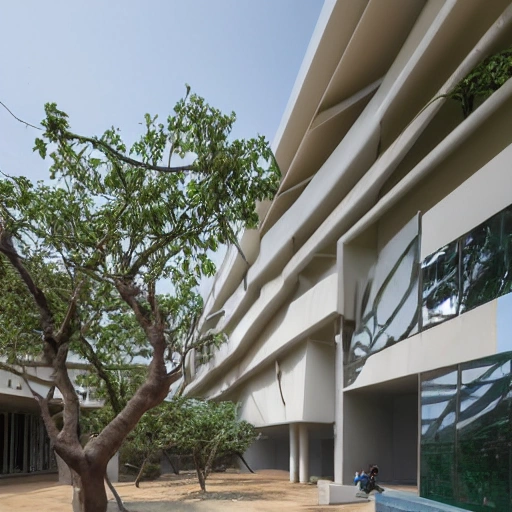Bringing together creativity, technology and sustainability, the...
Bringing together creativity, technology and sustainability, the National Institute of Design in Hyderabad is a modern-day oasis for aspiring designers. Designed by world-renowned architect BV Doshi, this campus serves as a source of inspiration and a hub for innovation. Embracing the rich cultural heritage of Hyderabad while embracing cutting-edge design practices, the NID campus is a vibrant and dynamic space that fosters collaboration and growth. From textiles and product design to graphics and animation, students here are empowered to turn their artistic visions into tangible realities. Join us in this unique artistic journey and become a part of the design revolution that is shaping India's future.Zaha Hadid Architects thesis level design art and culture elements, 3D acadamic block hostel blocks oat landscape parking canteen sports complex interior view tree concept ,cluster form ,fuctional spaces ,design evolution Modern architecture has incorporated the idea of incorporating open spaces, like lawns, into the design of buildings. These spaces serve not only as a part of the landscape, but also as interactive spaces where people can gather informally, hold cultural programs, and engage in social functions. The lawns can have built-in features like platforms and seating areas that enhance the outdoor experience. The presence of ancient monuments and open-air amphitheatres, surrounded by densely planted trees, adds to the aesthetic appeal and creates a unique atmosphere. Overall, lawns have become an integral part of modern architectural design, and their importance as a design criteria is being recognized and emphasized. Modern technology in architecture has enabled designers to address climate-specific challenges, such as the hot and dry climate in Ahmedabad. The design of the campus takes into account the climate and maximizes the use of natural light and ventilation to create comfortable and energy-efficient spaces. Courtyards are designed to remain in the shadow for most part of the day and sliding panels are installed to allow inflow of light into the workshops. Pockets of vegetation are incorporated into the design to provide shade and blend with the structure both inside and outside the building. The use of heat-resistant glass in metal frames for the workshops and rosewood frames for the studios helps to mitigate heat gain. The building is designed to capture wind from the riverside and cool the interiors through adjustable glazing and features like water bodies with jallis to filter cooled air. Overall, modern technology has enabled architects to create sustainable and comfortable buildings that respond to the local climate and environment.
{ "seed": "1067847269", "steps": 30, "width": 512, "height": 512, "version": "SD1.4_SH", "sampler_name": "k_dpm_2", "guidance_scale": 7.5 }
